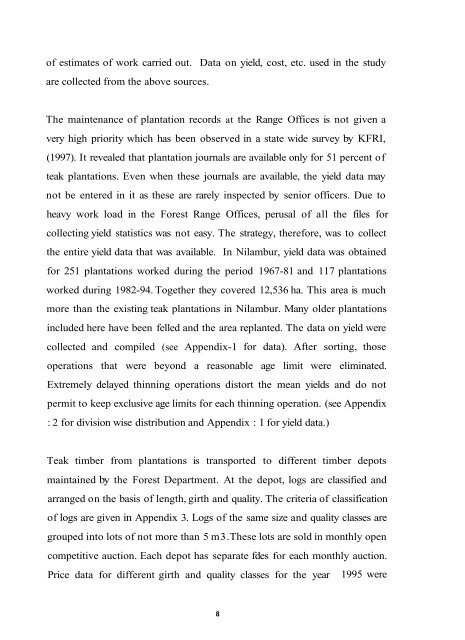TEAK PLANTATIONS IN NILAMBUR - Kerala Forest Research Institute
TEAK PLANTATIONS IN NILAMBUR - Kerala Forest Research Institute
TEAK PLANTATIONS IN NILAMBUR - Kerala Forest Research Institute
Create successful ePaper yourself
Turn your PDF publications into a flip-book with our unique Google optimized e-Paper software.
of estimates of work carried out. Data on yield, cost, etc. used in the study<br />
are collected from the above sources.<br />
The maintenance of plantation records at the Range Offices is not given a<br />
very high priority which has been observed in a state wide survey by KFRI,<br />
(1997). It revealed that plantation journals are available only for 51 percent of<br />
teak plantations. Even when these journals are available, the yield data may<br />
not be entered in it as these are rarely inspected by senior officers. Due to<br />
heavy work load in the <strong>Forest</strong> Range Offices, perusal of all the files for<br />
collecting yield statistics was not easy. The strategy, therefore, was to collect<br />
the entire yield data that was available. In Nilambur, yield data was obtained<br />
for 251 plantations worked during the period 1967-81 and 117 plantations<br />
worked during 1982-94. Together they covered 12,536 ha. This area is much<br />
more than the existing teak plantations in Nilambur. Many older plantations<br />
included here have been felled and the area replanted. The data on yield were<br />
collected and compiled (see Appendix-1 for data). After sorting, those<br />
operations that were beyond a reasonable age limit were eliminated.<br />
Extremely delayed thinning operations distort the mean yields and do not<br />
permit to keep exclusive age limits for each thinning operation. (see Appendix<br />
: 2 for division wise distribution and Appendix : 1 for yield data.)<br />
Teak timber from plantations is transported to different timber depots<br />
maintained by the <strong>Forest</strong> Department. At the depot, logs are classified and<br />
arranged on the basis of length, girth and quality. The criteria of classification<br />
of logs are given in Appendix 3. Logs of the same size and quality classes are<br />
grouped into lots of not more than 5 m3. These lots are sold in monthly open<br />
competitive auction. Each depot has separate fdes for each monthly auction.<br />
Price data for different girth and quality classes for the year 1995 were<br />
8

















